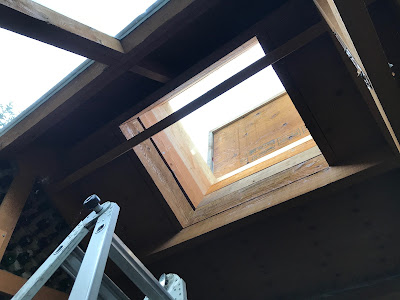For collecting rainwater off a roof, ideally you wouldn't want the first bit of water since it cleans the roof. A scupper is a device for diverting that first bit of water away, then allowing the remaining water to be collected. Let's build one and connect the roof to the cisterns.
We started by building custom ball valves for the scupper, consisting of a 3" ABS T-fitting with a wire-coat-hanger cage and a plastic toy ball as the valve.

We tested the valve action in a bucket of water to ensure it blocks water from entering the fitting... and it does!

The ball valve is installed inside a plastic 5 gallon bucket. The idea is that the water has to fill the bucket first, then overflow into the cisterns. As water fills the bucket, the plastic ball floats on the surface of the water until it seals against the T-fitting opening. The incoming water can then flow past the ball and into the cistern. Small holes are drilled into the bottom of the bucket to allow water to slowly drain before the next rainfall. Not sure if this will work so let's hope for the best!
Next we used 3" ABS pipe to connect the roof to the scupper/cistern inlet. We installed removable stainless steel mesh at the pipe inlet to block floating debris/insects/animals.

One system for each cistern. Note that any sediment will get trapped at the mouth of the pipe inlet since it will be raised above the roof surface by about 1". Any remaining sediment entering the system will get trapped in the scupper. The scuppers are fully accessible for cleaning.
Lastly, we installed custom scupper covers made of a 45 gallon steel drum cut in half. The covers prevent the sun's UV rays from making the plastic buckets brittle.
To complete the system we'll build a curb around the roof to direct the water into the pipes.







































